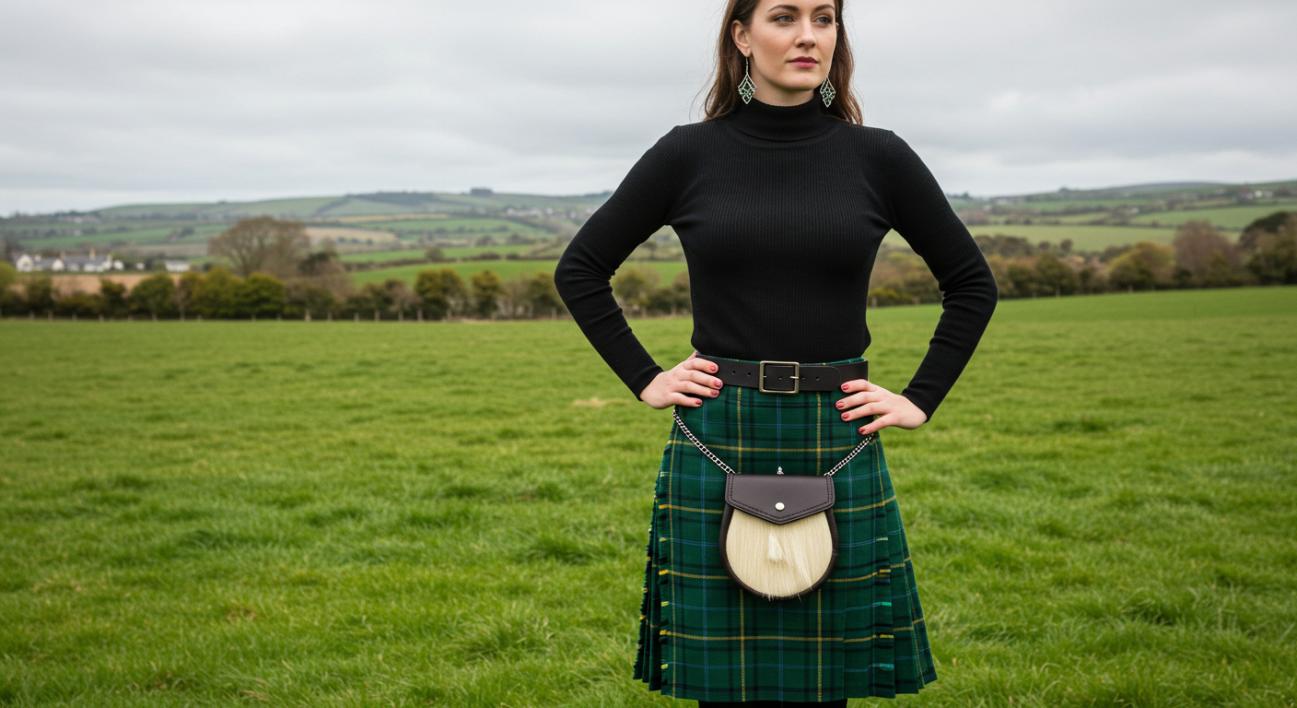The Perfect Fit: Finding the Right Size for Your Women’s Irish Kilt

Regarding the women's Irish kilt, one of the most important aspects is ensuring the perfect fit. A well-fitting kilt offers comfort and mobility and helps you feel confident and stylish, whether you are attending a formal event, a casual outing, or a St. Patrick's Day celebration. Unlike other garments that may only need a simple size check, a kilt requires careful attention to detail when it comes to getting the right fit.
Kilts have long been celebrated for their historical significance and role in traditional Irish culture, and they have become increasingly popular among women looking for both fashionable and functional garments. However, because of its distinct structure—pleats, waistband, and length—it's crucial to choose the right size to ensure it flatters your body and offers comfort.
In this blog post, we'll guide you through finding the perfect fit for your Irish kilts for women. From understanding key measurements to choosing the right fabric and fit, we will cover everything you need to know for a confident and stylish kilt experience.
1. Understanding the Structure of the Irish Kilt
Before diving into the specifics of sizing, it's essential to understand the typical structure of a women's irish kilts. The kilt is distinct in its design, featuring pleats that offer both visual appeal and functionality and a waistband that sits comfortably at the waist or hips, depending on the style.
- Pleats: The pleats define the kilt. Designers typically stitch them to allow freedom of movement, making the garment stylish and comfortable. Women often design the pleats to flatter the figure while offering practicality, especially for active wear.
- Waistband: The waistband plays a critical role in the fit. It should sit snugly without digging into your skin as you wear the kilt at the natural waist. However, some women may prefer their kilts to sit slightly lower, depending on body type and personal preference.
- Length: Kilts come in various lengths, from knee-length to full-length styles. The length you choose depends on the look you want and the event you're attending.
Each feature impacts how the kilt will fit and look, so paying attention to them when selecting your size is essential.
2. Key Measurements for the Perfect Fit
You need to take a few key measurements to find the perfect fit for your women's Irish kilt. These measurements will ensure that your kilt fits properly but is also flattering and comfortable.
Waist Measurement
The waist is the most important measurement for any kilt. The waistband should sit comfortably around your waist, allowing for ease of movement while providing a flattering fit. Here's how to measure your waist:
- Use a soft measuring tape and wrap it around your natural waist (the narrowest part of your torso).
- Ensure the tape is snug but not tight, and breathe normally when measuring.
Once you have your waist measurement, you can compare it to the sizing chart provided by the kilt maker to determine your size.
Hip Measurement
While the waistband is essential, the fit around the hips is just as crucial for ensuring comfort and style. The pleats should fall gracefully over your hips without feeling too tight or loose. To measure your hips:
- Stand with your feet together and measure the fullest part of your hips, usually about 7 to 9 inches below the waist.
- Ensure the measuring tape stays parallel to the ground, and measure while keeping the tape snug but not tight.
For those with curvier figures, or if you prefer a looser fit, considering the hip measurement will help ensure a smooth, comfortable fit.
Length Measurement
The kilt length will largely depend on personal preference and the event. A traditional kilt typically falls just above the knee, but some women may prefer a longer or shorter style. To measure the length:
- Measure from the natural waist to the point where you want the hem of the kilt to fall.
- A longer kilt that hits mid-calf or ankle-length might be ideal for a more formal look. For casual wear, knee-length kilts are a great option.
Kilts that are too long can look unflattering, while ones that are too short may not be comfortable for certain activities.
3. How to Choose the Right Waist Size
Once you have your measurements, selecting the correct waist size ensures comfort and avoids wardrobe malfunctions. Kilts typically come in either custom sizes or standard sizing, and you'll need to choose based on your waist measurement.
- Custom Waistbands: Some kilts offer customizable waistbands that can be adjusted to your exact measurements, offering a more tailored fit.
- Adjustable Waistbands: If you're unsure about your waist measurement or tend to fluctuate in size, consider kilts with adjustable waistbands. These kilts allow you to adjust the fit without tailoring, ensuring comfort regardless of size.
When selecting a waist size, don't forget to factor in your comfort level. A kilt that is too tight around the waist can be restrictive and uncomfortable, while a too-loose fit may cause the kilt to shift throughout the day.
4. Ensuring the Right Hip and Pleat Fit
The fit of the kilt around your hips is just as crucial as the waistband. Kilts with pleats should flow freely over the hips without being too tight or too loose.
- Pleat Adjustment: Pleats should sit flat against your back and flow naturally as you move. If the pleats feel too tight around the hips, consider sizing up or opting for a kilt made from a more flexible fabric. On the other hand, pleats that are too loose might make the kilt look boxy and less flattering.
For women with fuller hips, choose a kilt with more room in the hip area to ensure comfort and a flattering fit. The kilt will look chic and feel great when the pleats fall nicely and allow for natural movement.
5. Fabric and Fit: Understanding Material Choices
The material of the kilt plays a significant role in how it fits. Wool, cotton, and synthetic blends are the most common fabrics used in kilts, and each impacts fit and comfort.
- Wool Kilts: Wool is a traditional kilter fabric that offers structure and warmth. However, wool can also be a bit stiff. Hence, ensuring the kilt is well-tailored, particularly around the waist and hips, is essential.
- Cotton Kilts: Cotton offers a lighter, more breathable alternative to wool, ideal for warmer climates or casual occasions. A cotton kilt may provide more flexibility and comfort but not the same weight or structure as a wool kilt.
- Synthetic Blends: These fabrics often provide a more budget-friendly option and are more wrinkle-resistant. However, they may not offer the same breathability or natural feel as wool and cotton.
When choosing your fabric, consider both the season and your comfort needs. Fabric choice can also affect how the kilt hugs your body and falls over your hips.
6. Tailoring and Customization: Adjusting the Fit
Getting the right size is essential; sometimes, a little tailoring or customization can ensure a perfect fit.
- Length Alterations: If the kilt is too long or too short, taking it to a professional tailor can adjust the length to your preference.
- Taking In or Letting Out the Waist: Some kilts may need minor adjustments around the waist for a more fitted appearance. A tailor can help make these changes without affecting the overall design.
- Custom Kilts: If you're looking for a unique fit, consider investing in a custom kilt, where every measurement and detail is tailored to your preferences.
7. Final Tips for Finding the Perfect Fit
- Fit with Comfort in Mind: Remember, the right fit isn't just about looking good—it's about feeling good, too. Always prioritize comfort when choosing your size and fit.
- Be Open to Adjustments: Don't be afraid to make minor adjustments. A custom-tailored kilt can be an investment, ensuring the perfect fit for years.
- Use Size Charts: Always refer to sizing charts when shopping online. These charts are your best tool for choosing the correct size based on your measurements.
Conclusion
Finding the perfect fit for your women's Irish kilt is essential for ensuring comfort, style, and confidence. By taking accurate measurements, considering fabric choices, and opting for tailored or adjustable options, you can find a kilt that fits perfectly and flatters your body shape. Whether you are looking for something to wear to a special event or as part of your everyday wardrobe, the right-fitting kilt will help you feel your best while showcasing your love for Irish culture and heritage.


